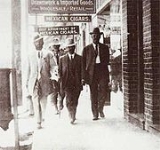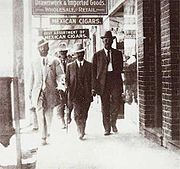
Roque González Garza
Encyclopedia
Roque González Garza was a Mexican
general and acting president of the Republic
from January to June 1915.
From 1908 he appeared in politics in opposition to the government of President Porfirio Díaz
. He was one of the first supporters of Francisco I. Madero
, whom he accompanied in his presidential campaign. He was director of revolutionary forces in Coahuila, and a federal deputy. During the election of 1910 Díaz had Madero (the opposition candidate) and 6,000 of his supporters jailed. González was arrested with Madero. Madero was able to escape and issued a call for armed revolt. González later joined him and fought in the battles of Casas Grandes
and Ciudad Juárez
.
After Madero assumed the presidency, González was his personal assistant and a member of his general staff. When Madero and Vice-President José María Pino Suárez
were murdered, González went to the north, joining the forces of Francisco Villa. He was promoted to general and he participated in the most important battles of the revolution against the Huerta
regime. These included the battles of Torreón
, San Pedro de las Colonias, Paredón, Saltillo
and Zacatecas
.
 He was the personal representative of Villa in the Aguascalientes Convention, where he was one of the most outstanding figures. He was chosen to preside at the Convention, and was one of the editors of the Manifiesto that the Convention published on November 13, 1914.
He was the personal representative of Villa in the Aguascalientes Convention, where he was one of the most outstanding figures. He was chosen to preside at the Convention, and was one of the editors of the Manifiesto that the Convention published on November 13, 1914.
On the fall of Conventionalist President Eulalio Gutiérrez
, he was chosen by the Convention as Gutiérrez's replacement. As a Conventionalist, he was in opposition to the Constitutionalist president, Venustiano Carranza
. González's term of office ran from January 16, 1915 to June 10 of the same year. On the latter date, by agreement of the Convention, he turned over power to Francisco Lagos Cházaro
and reentered private life in Mexico City.
The victory of the Constitutionalists forced to him into exile, where he remained several years, until after the death of Carranza. Years later he collaborated in the administration of General Manuel Ávila
. He was coauthor of the books La Batalla de Torreón (1914) and Apuntes para la Historia (1914), which recounted the events of the Mexican Revolution. He died in 1962.
Mexico
The United Mexican States , commonly known as Mexico , is a federal constitutional republic in North America. It is bordered on the north by the United States; on the south and west by the Pacific Ocean; on the southeast by Guatemala, Belize, and the Caribbean Sea; and on the east by the Gulf of...
general and acting president of the Republic
President of Mexico
The President of the United Mexican States is the head of state and government of Mexico. Under the Constitution, the president is also the Supreme Commander of the Mexican armed forces...
from January to June 1915.
From 1908 he appeared in politics in opposition to the government of President Porfirio Díaz
Porfirio Díaz
José de la Cruz Porfirio Díaz Mori was a Mexican-American War volunteer and French intervention hero, an accomplished general and the President of Mexico continuously from 1876 to 1911, with the exception of a brief term in 1876 when he left Juan N...
. He was one of the first supporters of Francisco I. Madero
Francisco I. Madero
Francisco Ignacio Madero González was a politician, writer and revolutionary who served as President of Mexico from 1911 to 1913. As a respectable upper-class politician, he supplied a center around which opposition to the dictatorship of Porfirio Díaz could coalesce...
, whom he accompanied in his presidential campaign. He was director of revolutionary forces in Coahuila, and a federal deputy. During the election of 1910 Díaz had Madero (the opposition candidate) and 6,000 of his supporters jailed. González was arrested with Madero. Madero was able to escape and issued a call for armed revolt. González later joined him and fought in the battles of Casas Grandes
Casas Grandes
Casas Grandes is the contemporary name given to a pre-Columbian archaeological zone and its central site, located in northwestern Mexico in the modern-day Mexican state of Chihuahua. It is one of the largest and most complex sites in the region...
and Ciudad Juárez
Ciudad Juárez
Ciudad Juárez , officially known today as Heroica Ciudad Juárez, but abbreviated Juárez and formerly known as El Paso del Norte, is a city and seat of the municipality of Juárez in the Mexican state of Chihuahua. Juárez's estimated population is 1.5 million people. The city lies on the Rio Grande...
.
After Madero assumed the presidency, González was his personal assistant and a member of his general staff. When Madero and Vice-President José María Pino Suárez
José María Pino Suárez
José María Pino Suárez was a Mexican statesman, revolutionary, poet, journalist and jurist who served as Vice President of Mexico , Secreatry of Education and Governor of Yucatán...
were murdered, González went to the north, joining the forces of Francisco Villa. He was promoted to general and he participated in the most important battles of the revolution against the Huerta
Victoriano Huerta
José Victoriano Huerta Márquez was a Mexican military officer and president of Mexico. Huerta's supporters were known as Huertistas during the Mexican Revolution...
regime. These included the battles of Torreón
Torreón
Torreón is a city and seat of the surrounding municipality of the same name in the Mexican state of Coahuila. As of 2010, the city's population was 608,836 with 639,629 in the municipality. The metropolitan population, including Matamoros, Coahuila, and Gómez Palacio and Lerdo in adjacent Durango,...
, San Pedro de las Colonias, Paredón, Saltillo
Saltillo
Saltillo is the capital city of the northeastern Mexican state of Coahuila and the municipal seat of the municipality of the same name. The city is located about 400 km south of the U.S. state of Texas, and 90 km west of Monterrey, Nuevo León....
and Zacatecas
Zacatecas
Zacatecas officially Estado Libre y Soberano de Zacatecas is one of the 31 states which, with the Federal District, comprise the 32 Federal Entities of Mexico. It is divided in 58 municipalities and its capital city is Zacatecas....
.

On the fall of Conventionalist President Eulalio Gutiérrez
Eulalio Gutiérrez
Eulalio Gutiérrez Ortiz was elected provisional president of Mexico during the Aguascalientes Convention and led the country for a few months between November 6, 1914, and January 16, 1915....
, he was chosen by the Convention as Gutiérrez's replacement. As a Conventionalist, he was in opposition to the Constitutionalist president, Venustiano Carranza
Venustiano Carranza
Venustiano Carranza de la Garza, was one of the leaders of the Mexican Revolution. He ultimately became President of Mexico following the overthrow of the dictatorial Huerta regime in the summer of 1914 and during his administration the current constitution of Mexico was drafted...
. González's term of office ran from January 16, 1915 to June 10 of the same year. On the latter date, by agreement of the Convention, he turned over power to Francisco Lagos Cházaro
Francisco Lagos Cházaro
Francisco Jerónimo de Jesús Lagos Cházaro Mortero was acting President of Mexico designated by the Convention of Aguascalientes from June 10, 1915 to October 10, 1915....
and reentered private life in Mexico City.
The victory of the Constitutionalists forced to him into exile, where he remained several years, until after the death of Carranza. Years later he collaborated in the administration of General Manuel Ávila
Manuel Ávila Camacho
Manuel Ávila Camacho served as the President of Mexico from 1940 to 1946.Manuel Ávila was born in the city of Teziutlán, a small town in Puebla, to middle-class parents, Manuel Ávila Castillo and Eufrosina Camacho Bello. He had several siblings, among them sister María Jovita Ávila Camacho and...
. He was coauthor of the books La Batalla de Torreón (1914) and Apuntes para la Historia (1914), which recounted the events of the Mexican Revolution. He died in 1962.

